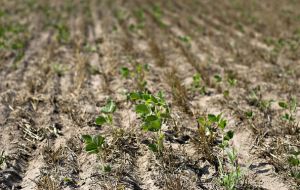MercoPress. South Atlantic News Agency
Drought stretching across US threatens economies of farming states and food prices
 USDA declared 1.000 counties in 26 states natural-disaster areas, the biggest such declaration ever
USDA declared 1.000 counties in 26 states natural-disaster areas, the biggest such declaration ever A worst-in-a-generation drought from stretching across the United States is damaging crops and rural economies and threatening to drive food prices to record levels. Agriculture, though a small part (1.2%) of the 15.5 trillion dollars US economy, had been one of the most resilient industries in the past three years as the country struggled to recover from the recession.
The US Department of Agriculture declares July 11 that more than 1,000 counties in 26 states are natural-disaster areas, the biggest such declaration ever. The designation makes farmers and ranchers in affected counties -- about a third of those in the entire country -- eligible for low-interest loans to help manage the drought, wildfires or other disasters.
Corn on Monday rose to the highest in 10 months while soybeans increased to the costliest since 2008.
“The drought will have regional, national and even international impacts,” Ernie Goss, a professor of economics at Creighton University in Omaha, Nebraska, said in an e-mail. Farm income, which has underpinned the growth of many rural states, will be under “significant downward pressure,” Goss said.
The USDA has said the drought is the worst since 1988 and cut its forecast for the corn harvest for the year by 12%.
Indiana has asked residents to conserve water and sent notices to its largest users to request specific cuts as it faces “possibly a historic drought,” according to Al Shipe, a National Weather Service hydrologist in Indianapolis.
The acreage affected by drought has expanded rapidly, according to the government-funded US Drought Monitor in Lincoln, Nebraska. In the high-plains states of North Dakota, South Dakota, Wyoming, Nebraska, Colorado, and Kansas, the areas designated as being in moderate to exceptional drought rose to 84% as of July 10 from 74% a week earlier.
In the Midwest, 63% of the region was in drought as of July 10, up from 53% on July 3. Key corn-growing states, including Indiana, Illinois, Iowa and Missouri, are listed as abnormally dry or worse. Yet within those regions, some states have fared better, such as Minnesota and North Dakota, where about 25% of each state is experiencing drought.
Iowa Governor Terry Branstad said he’s still assessing the scale of the drought’s economic impact, which he said varies throughout the state. “We’re starting to become concerned and we’ve seen some deterioration of the crops,” he said in an interview July 14 during the National Governors Association Conference in Williamsburg, Virginia. The drought looks “to have hit at a very key time,” in the growth cycle of corn and soybean crops, said Missouri Governor Jay Nixon in an interview during the same conference, and “could be dramatically affected.”
The biggest US crop, worth 76.5 billion dollars last year, corn is the main ingredient in the feed of chicken, cattle and hogs. Meat, poultry and fish prices surged 7.4% last year and are expected to gain as much as 4.5% this year as rising prices make animal feed more expensive. Soybeans have risen 21% since mid-June and wheat has climbed 41%.
Rising prices can benefit farmers who have successful harvests or took out sufficient insurance on their fields. Farm cash receipts are now expected to be a record 140.5 billion dollars for the crop year of 2012-13, up 4% from 2011-2012, according to a report from JPMorgan Chase & Co on July 11.
Yet with agriculture’s modest share of the US economy, a single season’s drought may have little lasting impact on the national economy, said Bruce Babcock, an economics professor at Iowa State University in Ames.
Even the impact on food prices will likely be fleeting, he said. “If it’s a one-year drought you’ll see some impact on food-price indexes, but it will be a one-time shot,” said Babcock. “It won’t be a sustained inflation.”




Top Comments
Disclaimer & comment rules-

Read all commentsAnd as always US does the BLS will report 0.000001% price food increase.
Jul 20th, 2012 - 06:13 am 0Books cooked and everyone happy with a fake 3% inflation.
Commenting for this story is now closed.
If you have a Facebook account, become a fan and comment on our Facebook Page!